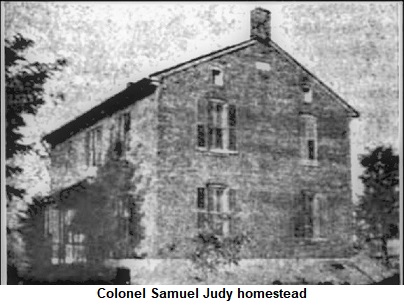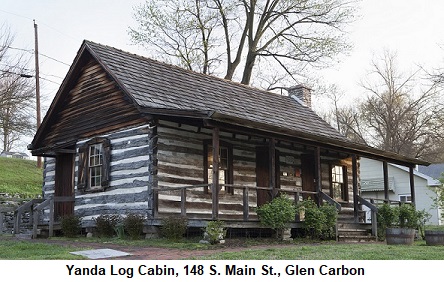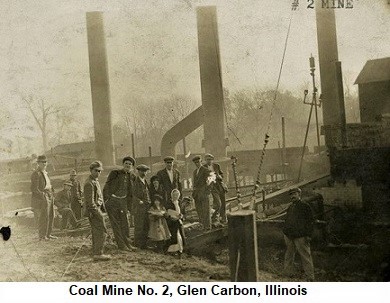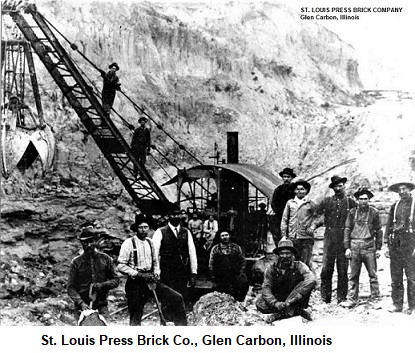Early Glen Carbon History
Glen Carbon Newspaper Articles
Glen Carbon began as many different small settlements – Peters
Station to the west, Mont Station to the east, and the original
Goshen
The Yanda Log Cabin
The Yanda Log Cabin is believed to have been constructed by
blacksmith William Yanda in 1853.
 William
Yanda and his wife, Anna Zeola Yanda, were immigrants from Bohemia,
Austria. They and their ten children lived in the cabin. Their
eldest son, Frank, became a blacksmith. After moving to other towns
to engage in his craft, he returned home with his family and raised
eleven children in the cabin. Frank sold the cabin to his son, Frank
Jr., who was one of the early mayors of Glen Carbon. Eventually the
village bought the lot with the existing house which was constructed
around the cabin. After discovering the cabin underneath, renovation
began in 1989 and concluded in 1992. The cabin now serves as an
addition to the Glen Carbon Museum.
William
Yanda and his wife, Anna Zeola Yanda, were immigrants from Bohemia,
Austria. They and their ten children lived in the cabin. Their
eldest son, Frank, became a blacksmith. After moving to other towns
to engage in his craft, he returned home with his family and raised
eleven children in the cabin. Frank sold the cabin to his son, Frank
Jr., who was one of the early mayors of Glen Carbon. Eventually the
village bought the lot with the existing house which was constructed
around the cabin. After discovering the cabin underneath, renovation
began in 1989 and concluded in 1992. The cabin now serves as an
addition to the Glen Carbon Museum.
Coal Mining
After the Civil War, coal mining became a large industry in the
area, as the future Glen Carbon was located on top of vast coal
reserves. Seven veins of coal, ranging in depth from 90 to 400 feet,
ran beneath the surface. In 1891, the Madison Coal Corporation was
founded by three St. Louis businessmen – William E. Guy, James L.
Blair, and George O. Carpenter Jr. – who proposed to mine coal and
other minerals. William Guy, a geologist and engineer, served as
President. The Madison Coal Corporation operated four coal mines in
the area – three mines in Glen Carbon, and one in Edwardsville. The
company hired Anton Daenzer, a mining expert out of Belleville.
Daenzer was named District Superintendent of the corporation and was
in charge of all company mines. A large, two-story Victorian home
was built for the Daenzer family on a bluff overlooking Glen Carbon,
near the company offices on Collinsville Avenue. The company office
building still stands on Collinsville Avenue at the bike trail,
however the superintendent’s home was razed many years ago.
Madison Coal Company’s philosophy was to create a “company town,”
which provided all the amenities necessary for workers. The company
owned and platted much of the land in the future village and built
rental houses for miners. They donated lots for churches, schools,
and a firehouse/village hall. It provided access to supplies through
the Company Store. A large, well-appointed park was provided by the
company, and awards were given to the miner with the best garden and
yard. While many of the houses in Old Town were built by the coal
company, the most notable were the nine saltbox houses which lined
lower Main Street. These houses were the same two-story, two family
houses built by the Press Brick Company’s “Brickyard Row” on Upper
Main Street. The “Blue Row,” located between School Street and
Collinsville Avenue, differed in that these houses did not have
brick porches and were all painted blue. Four of these houses still
stand today.
Mine No. 2 was the largest and most productive mine of the four. It was situation north of the bike trail, just east of Madison
Avenue. Located on the Illinois Central tracks, a large coal washer
was constructed nearby for the washing of the coal prior to loading
onto the train cars. In 1934, the last mine in Glen Carbon was
closed permanently. In 1988, a project funded under “The Mine Land
Reclamation Act” obliterated nearly all traces of the mine.
It was situation north of the bike trail, just east of Madison
Avenue. Located on the Illinois Central tracks, a large coal washer
was constructed nearby for the washing of the coal prior to loading
onto the train cars. In 1934, the last mine in Glen Carbon was
closed permanently. In 1988, a project funded under “The Mine Land
Reclamation Act” obliterated nearly all traces of the mine.
In 1892, seventy-six residents petitioned the county court, and the
village of Glen Carbon was officially incorporated on June 6, 1892.
The name Glen Carbon means “valley of coal,” which reflects the
importance of the history of coal mining there.
The Railroad
There were two depots for the railroad erected – one running east
and west, and the second running north and south. Rail travel was
important to the businesses and mining companies and travelers. It
was easy to board the Illinois Central and Clover Leaf railroads,
who made several trips a day to St. Louis and back. The trains
carried coal and other goods to various locations.
St. Louis Brick Company
Another important industry in Glen Carbon was the St. Louis Press
Brick Company, which burned down in the 1930s. After being rebuilt,
it burned once again and was never opened again. Bricks made in Glen
Carbon were used in the building of the 1904 World’s Fair buildings
in Forest Park.